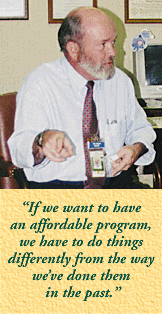

  Tom Heenan is the assistant
manager for environmental quality at the Savannah River Site.
Heenan has been at SRS since 1989 and in his present
position since 1993, but his tenure with DOE and its
predecessor agencies spans several decades. Heenan has
worked in a number of programs and locations throughout
the DOE complex. According to Heenan, his experience in
these programs has shown that "smarter ways and new
technologies save money." Initiatives spoke
with Heenan on April 13. Tom Heenan is the assistant
manager for environmental quality at the Savannah River Site.
Heenan has been at SRS since 1989 and in his present
position since 1993, but his tenure with DOE and its
predecessor agencies spans several decades. Heenan has
worked in a number of programs and locations throughout
the DOE complex. According to Heenan, his experience in
these programs has shown that "smarter ways and new
technologies save money." Initiatives spoke
with Heenan on April 13. The U.S. Department of Energy's Savannah River Site is gaining a reputation for accomplishing cleanup. The key is in replacing the outmoded pump-and-treat approach with innovative technologies. According to Heenan, "If we want to have an affordable program, we have to do things differently from the way we've done them in the past." A change in
culture Also in 1994, SRS held a vendor forum. The two-day event attracted about 1,000 potential contractors to hear about environmental problems and technology needs at SRS. Heenan says that through the forum, "We found people that had real good ideas and no market, and we had a niche problem and no solution." As a result, the site funded several vendors to demonstrate their technologies doing actual cleanup. By September 1995, SRS was poised to have a series of breakthrough management sessions involving people from the site, DOE headquarters, and regulators. As Heenan puts it, they were committed to taking the SRS cleanup program "out of the doldrums and do something special with it." Those sessions resulted in a commitment statement signed by all the participants, including the regulators. Among the commitments was one to "incorporate innovative technologies" in cleanup operations. SRS
philosophy
Another philosophy at SRS is to get away from pump-and-treat cleanup. Heenan says they are "using a whole suite of things that together make the most cost-effective approach. I wouldn't say pump and treat never is the right answer, but the number of great ideas we've had working for other answers is just fantastic." For example, cleanup at the A/M Area at SRS, the world's largest water treatment project, began with pumping and treating. Now Heenan says there are about 10 other approaches being used to chase after a complicated plume. Keys to
success One result of the push from management has been the Environmental Restoration (ER) Technology Panel. There was a time when technology developers in the laboratory and line program managers doing the cleanup weren't connected. Now they sit on the same panel where they can review site needs and discuss potential solutions together. At first, many of the technologies discussed were from people developing them at the site. Later, the panel started looking to industry for ideas. Most recently, the panel is working to increase communication with people at other DOE and Department of Defense sites that have similar problems. The panel is jointly chaired by managers representing the line organization and the Savannah River Technology Center, so there is ownership from both organizations. The panel, which meets monthly, screens all new technologies before they are used at the site. The site has also learned the importance of getting regulators involved early and has worked to build a mutual trust with them. SRS has a formal technology demonstration agreement with state and federal regulators that outlines the process everyone follows for selecting, evaluating, and deploying new technologies. Heenan says the people at EPA Region IV and the South Carolina Department of Health and Environmental Control "want to be smart regulators who drive actual accomplishment in a cost-effective way" and not generate paper delays. Heenan says three important things in cleanup are, "Don't move a lot of water, don't move a lot of soil, and don't move a lot of paper." According to Heenan, the Citizens Advisory Board at SRS is also supportive of using innovative ways to accelerate cleanup. He says, "The SRS CAB is one of the most active in the country, and they see themselves as encouraging us to do smarter, more cost-effective things." Some
obstacles Another hindrance is an aversion to risk. However, Heenan sees the real risk in not applying innovative technologies. For example, pump and treat may appear to be low risk; but in the long run, it costs more and takes longer. Heenan explains, "People need to know that risk is incurred by sticking to the conventional approaches." Another problem Heenan sees is when technology developers are lab focused. During a 1993 visit from Thomas Grumbly, then assistant secretary for environmental management, Grumbly said the site "needed to get out of the lab and get relevant." As a result, SRS began demonstrating technologies in actual cleanup applications rather than in laboratory settings. Advice for
technology developers Heenan also recommends that the Office of Science and Technology use its funding to act as a technology advocacy organization that understands technology or cleanup needs and is able to transfer information about what is being used at other sites to address those needs. His advice is, "Track the savings [from using innovative cleanup approaches] and knock down the barriers on where the good ideas came from." |